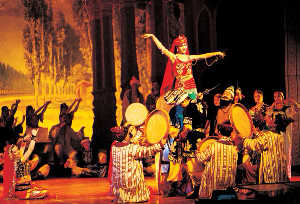| |
Rescue and Protection of Xinjiang Traditional Arts
( 2005-09-13 )
 Xinjiang, known as the Western Regions (Xiyu in Chinese in ancient China, has long been a meeting place of many ethnic groups and their diverse culture, languages, and beliefs. Xinjiang, known as the Western Regions (Xiyu in Chinese in ancient China, has long been a meeting place of many ethnic groups and their diverse culture, languages, and beliefs.
The first Xinjiang residents were pantheists and worshiped Nature. Their rituals and ceremonies were the foundation for future music and dance styles, and theirrock paintings have stood as vivid reflections of their work, life, and forms of entertainment.
In the earlyHan Dynasty(206BC-220AD), theSilk Road, a vital traffic route across Eurasia, gradually took shape, forging a path through the oases at the northern side of theKunlun Mountains, and the north and south faces of the Tian Mountains in Xinjiang. It boosted the economies in those areas, helpedBuddhismto spread eastward, and facilitated the intermingling and cross-fertilization of such great ancient civilizations as those of the Chinese inland in the East, India in the South, and Persia, Babylon, Egypt, Greece, and Rome in the West.
As a result, a cluster of "ancient Xiyu civilizations" emerged successively around the Tarim Basin and at theTurpan-Hami Basin, including Yutian (today's Hotan), Qiuci (today's Kuche), Gaochang (today's Turpan), Shule (today'sKashgar), and Yizhou (today's Hami). At these places, music, dance, andacrobaticsrose to their height in the Sui (581-618) and Tang (618-907) dynasties, exerted a gradual influence on the Chinese inland, and contributed indelibly to the arts of China and even the world.
In the Song Dynasty (960-1279), Xinjiang experienced a volatile period in its history. Nevertheless, the time-honored arts of music, dance, theater,storytelling/chanting, and acrobatics were still being developed and handed down by the Xinjiang people over generations. Today, this heritage still stands as a rich historical and inspirational source for contemporary Xinjiang's theatrical arts.
|
|

